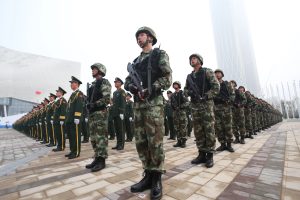On October 14, China’s People’s Liberation Army (PLA) began military drills surrounding Taiwan. Dubbed “Joint Sword-2024B,” the drills continue the large-scale military exercises the PLA held around Taiwan in April 2023 (known simply as Joint Sword) and May 2024 (Joint Sword-2024A).
According to a spokesperson from the PLA Eastern Theater Command, the drills included troops from the PLA “Army, Navy, Air Force, and Rocket Force” and were conducted “in the Taiwan Strait and areas to the north, south and east of Taiwan Island.” The spokesperson described the exercises as focusing on “sea-air combat-readiness patrol, blockade on key ports and areas, assault on maritime and ground targets, as well as joint seizure of comprehensive superiority.”
“The drill also serves as a stern warning to the separatist acts of ‘Taiwan independence’ forces. It is a legitimate and necessary operation for safeguarding national sovereignty and national unity,” the spokesperson said.
Taiwanese officials had predicted that China would hold military exercises as a follow-up to President Lai Ching-te’s first National Day address on October 10. Lai has a history of pro-independence remarks, although as vice president to President Tsai Ing-wen, and now as president himself, he has embraced her manta of maintaining the status quo. Beijing, however, considers Lai to be a pro-independence “troublemaker” and reacts accordingly to his major moves – regardless of what Lai actually says.
The previous round of Joint Sword exercises followed Lai’s inauguration; the latest drills were ostensibly a response to his remarks at Taiwan’s National Day celebration. Chen Binhua, a spokesperson for China’s Taiwan Affairs Office, accused Lai of advocating a “new two-state theory” of “Taiwan independence.” Chen particularly objected to Lai’s repeated emphasis on Taiwan’s democracy, complaining that “different systems are not an obstacle preventing unification, much less an excuse for splitting [Taiwan from the mainland].”
Lai’s “scheming ‘independence’ provocation is the root problem facing peace and stability in the Taiwan Strait, and will bring disaster to the people of Taiwan,” Chen warned.
The military drills were thus supposed to be a response to Lai’s “provocation.” However, as Brian Hioe noted in his analysis of Lai’s address, even before National Day Reuters “reported that China was likely to launch drills around Taiwan after Lai’s speech – with the implication being that this would take place regardless of what Lai actually said.”
Taiwan’s Presidential Office, quoting a line from Lai’s National Day remarks, insisted that “Taiwan is resolved in our commitment to uphold peace and stability in the Taiwan Strait.” In a statement, the Presidential Office said that “China should face the reality of the existence of the Republic of China (Taiwan)… It should cease military provocations that undermine regional peace and stability, and stop threatening Taiwan’s democracy and freedom.”
The United States said it was “seriously concerned” by the PLA drills. “The PRC response with military provocations to a routine annual speech is unwarranted and risks escalation,” the U.S. State Department spokesperson said (the PRC is an abbreviation of China’s official name, the People’s Republic of China).
“We call on the PRC to act with restraint and to avoid any further actions that may undermine peace and stability across the Taiwan Strait and in the broader region, which is essential to regional peace and prosperity and a matter of international concern,” the spokesperson added.
China’s Foreign Ministry spokesperson Mao Ning rebutted the criticism, insisting that “China has always been committed to maintaining regional peace and stability, to which countries in this region bear witness.” Instead, she said, “For anyone who cares about peace and stability across the Taiwan Strait, they need to stand against ‘Taiwan independence’ first and foremost.”
The drills ended after just one day, shorter than the two-day span of “Joint Sword-2024A” in May. Analysts on X also pointed out that the PLA-denoted zones for the drill, while still including areas to the west, north, and east of Taiwan, were smaller than the May exercises or the Joint Sword drills of April 2023.
Perhaps most importantly, the drills are another move to routinize large-scale military maneuvers by the PLA in Taiwan’s immediate vicinity. Even the evolution in nomenclature stresses this point: from no name (the drills in August 2022) to “Joint Sword” to “Joint Sword-2024A,” implying both multiple drills in 2024 and the continuation of the exercises into future years.
But while Beijing clearly sees tactical gains from normalizing such actions, it also carries risks. As Roshi Doshi, director of the Council on Foreign Relation’s China Strategy Initiative and formerly a China hand on the Biden administration’s National Security Council, noted on X, “Lai dialed back his 10/10 speech from his inaugural. So China is validating those who say no matter what Taiwan does, no matter what Lai does, they will escalate. Not a wise policy.”
































